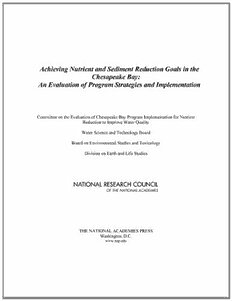
Achieving Nutrient and Sediment Reduction Goals in the Chesapeake Bay: An Evaluation of Program Strategies and Implementation PDF
259 Pages·2011·5.854 MB·English
Most books are stored in the elastic cloud where traffic is expensive. For this reason, we have a limit on daily download.
Preview Achieving Nutrient and Sediment Reduction Goals in the Chesapeake Bay: An Evaluation of Program Strategies and Implementation
Description:
The Chesapeake Bay is North America's largest and most biologically diverse estuary, as well as an important commercial and recreational resource. However, excessive amounts of nitrogen, phosphorus, and sediment from human activities and land development have disrupted the ecosystem, causing harmful algae blooms, degraded habitats, and diminished populations of many species of fish and shellfish. In 1983, the Chesapeake Bay Program (CBP) was established, based on a cooperative partnership among the U.S. Environmental Protection Agency (EPA), the state of Maryland, and the commonwealths of Pennsylvania and Virginia, and the District of Columbia, to address the extent, complexity, and sources of pollutants entering the Bay. In 2008, the CBP launched a series of initiatives to increase the transparency of the program and heighten its accountability and in 2009 an executive order injected new energy into the restoration. In addition, as part of the effect to improve the pace of progress and increase accountability in the Bay restoration, a two-year milestone strategy was introduced aimed at reducing overall pollution in the Bay by focusing on incremental, short-term commitments from each of the Bay jurisdictions. The National Research Council (NRC) established the Committee on the Evaluation of Chesapeake Bay Program Implementation for Nutrient Reduction in Improve Water Quality in 2009 in response to a request from the EPA. The committee was charged to assess the framework used by the states and the CBP for tracking nutrient and sediment control practices that are implemented in the Chesapeake Bay watershed and to evaluate the two-year milestone strategy. The committee was also to assess existing adaptive management strategies and to recommend improvements that could help CBP to meet its nutrient and sediment reduction goals. The committee did not attempt to identify every possible strategy that could be implemented but instead focused on approaches that are not being implemented to their full potential or that may have substantial, unrealized potential in the Bay watershed. Because many of these strategies have policy or societal implications that could not be fully evaluated by the committee, the strategies are not prioritized but are offered to encourage further consideration and exploration among the CBP partners and stakeholders.
See more
The list of books you might like
Most books are stored in the elastic cloud where traffic is expensive. For this reason, we have a limit on daily download.
